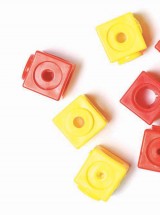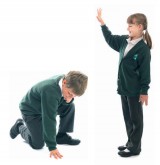Mike Askew has a hands on way to help children estimate and measure with greater confidence and efficiency...
When first learning how to represent quantities in linear form, children will often use a number track. Later, they progress to using number lines. But although the two seem similar, the move from the former to the latter is conceptually difficult.
On a number track objects can be placed one to each space, which makes it easy to see the correlation between the number of objects and the number of spaces. However, on a number line children count how many points are marked on the line; rather than the spaces themselves.
The best way to help children make this distinction is to ask them to construct their own number line.
 I gather together a collection of transparent containers – cut down 2- litre pop bottles – making sure there’s one for every group, plus a few extra. I then put between 15 and 30 Unifix cubes in each pot. These need to be sorted so that there are only two colours per pot (I get the children to sort the cubes out the week before). About half of the cubes in each pot need to be joined as pairs; the rest stay as singles.
I gather together a collection of transparent containers – cut down 2- litre pop bottles – making sure there’s one for every group, plus a few extra. I then put between 15 and 30 Unifix cubes in each pot. These need to be sorted so that there are only two colours per pot (I get the children to sort the cubes out the week before). About half of the cubes in each pot need to be joined as pairs; the rest stay as singles.
I also prepare several strips of sugar paper – around 60cm long and 15cm wide. Several of these have a line drawn horizontally through the centre, which is marked zero at one end and 30 at the other.
Finally, I put together a string of 30 cubes using two different colours, alternating the colour every five cubes. This is then hung tightly across the board so that any sagging is minimal. (See fig. 1)
![]()
I hold up one of the extra pots of cubes.
“How many cubes do you think are in this pot? Turn to the person next to you and tell them how many you think there are.”
Children share their estimates and I jot these down on the board until I’ve collected about six. Suppose there are 25 cubes in the pot and the children estimate 20, 19, 30, 22, 18 and 33. I draw a number line, marking one end zero and the other a multiple of 10 greater than the largest estimate - 40 in this case. I choose one of the ‘middling’ estimates.
“We are going to mark 22 on this line that goes from zero to 40. Talk to your partner about where you think 22 should go.”
A child comes to the board and indicates where they think 22 might be best placed. The class discusses what they think of this suggestion and we eventually agree on where to put the mark with 22 written below it. At this stage it is likely that the children will not be very accurate but I’m not too worried about that as the point of the lesson is to work on this.
“OK, so where is 19 going to go? Should 19 should go to the left or the right of 22? Talk to your partner.”
When the estimates are on the line, I tip the cubes onto the floor and ask a child to count them. Quite often they want to split the paired cubes into singles to make the counting easier. I stop them and we talk about whether we can count the cubes without splitting them. We separate out the pairs and discuss how counting in twos can be quicker. The challenge here is to count in twos to enumerate the cubes joined together, and then to switch to counting in ones to continue with the singles. We often need to practice this a few times.
We mark the actual number of cubes on the number line and discuss how close this is to the estimates.
“On your tables there is a pot of cubes and paper with a blank number line on it. In your groups you are going to do what we’ve just done all together. Have a look at the cubes in the pot and each person decide how many cubes they think there are. Mark your estimate on the number line. When everyone has marked their estimate then tip the cubes out of the pot and count them.”
I wander round checking that everyone is clear about the challenge and then watch the ways they go about estimating and counting.
“Have a look at how you have recorded the numbers here. Do they really go in the order 17, 15, 19?”
Any group that finishes quickly can have a different pot of cubes to repeat the process.
When each group has estimated and counted at least one pot of cubes I bring everyone back together. We look at the various ways they positioned the numbers on the lines and how accurate their estimates were.
“Have a look at the cubes I have strung up here. How many are there altogether?”
I watch out for the children who appear to be counting the cubes in ones and those who use the groups of five to help them find the total. We establish there are 30 by counting them in fives. Each group tells us what the total number of cubes in their pot was and we work on where to mark this number on the board below the string of cubes.
“23. Who can tell me where to mark this? Robyn? You want the third cube after the second set of 5 red cubes? Let’s see, that would be 5, 10, 15, 20, 21, 22, 23. Does everyone agree? Now where shall I make the mark, in the middle of cube 23 or at the end of it?”
The main teaching point here is that the mark on the line needs to come at the end of the cube rather than in the middle of it. We repeat this until all the numbers of cubes are marked on the line.
I then take a stick of five cubes (in a single colour) and show how these can be used to make a 0–30 number line: one end is marked zero and the other 5 before the stick is shifted across and the process repeated.
“What will I mark at this position? Yes, 10 because I’ve gone 5, 10.”
I continue to 30 and then send the children off in pairs to make their own 0-30 number line marked in 5s.
 As children complete their number lines, they collect together a large handful of cubes and join these to make one long stick. Placing this against their number line, they mark the end of the stick.
As children complete their number lines, they collect together a large handful of cubes and join these to make one long stick. Placing this against their number line, they mark the end of the stick.
“Can you use the marks and numbers on your number line to help you figure out how many cubes there are altogether without counting them all?”
With the class back together, we look at how the markings in fives on the number line can help us find the total number of cubes in a stick without counting them all in ones.
How to be a singing school
Ace-Music
Why Boarding School Fiction Feels Comfortably Familiar
Ace-Classroom-Support
